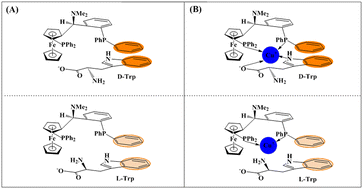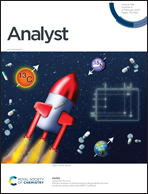A chiral sensing platform based on a multi-substituted ferrocene–cuprous ion complex for the discrimination of electroactive amino acid isomers
Abstract
An electrochemical chiral sensing platform based on a multi-substituted ferrocene–cuprous ion (Cu+) complex is constructed for the discrimination of electroactive amino acid (AA) isomers. Due to the opposite configurations of the AA isomers, the developed multi-substituted ferrocene–Cu+ can preferably combine with a right-handed AA (D-AA) isomer to form the ternary complex of multi-substituted ferrocene–Cu+-D-AA through π–π interactions, resulting in higher peak currents of D-AA. Therefore, the isomers of electroactive AA can be successfully discriminated. Among the tested electroactive AA isomers, the chiral sensing platform exhibits higher discrimination capability toward the isomers of tryptophan (Trp) than that of tyrosine (Tyr) and cysteine (Cys), which might be ascribed to the stronger π–π interactions between the benzene ring of the multi-substituted ferrocene and the indole ring of the Trp isomers.

- This article is part of the themed collection: 150th Anniversary Collection: Electrochemistry and Electroanalytical Approaches


 Please wait while we load your content...
Please wait while we load your content...